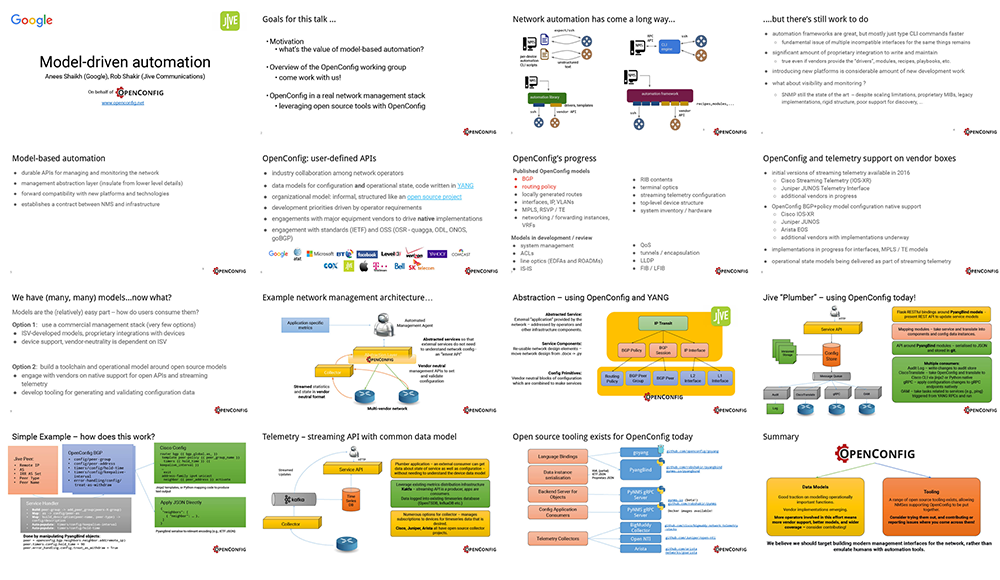NANOG 90: Pondering Abstractions
tech Tech · OpenConfig · YANGI had the pleasure of giving the keynote presentation at NANOG90 - sharing some thoughts and lessons that we have learnt in the 10 years since we started the OpenConfig project.
This was a really enjoyable presentation to put together and give. It balanced being able to look back at what we’ve learnt, and also think about some important lessons that I wanted to share with the networking community.
Reimagining Network Devices
tech OpenConfig · Tech · YANGAlmost 10 years ago, there was a shift in the IP networking industry. The move towards SDN, and its adoption by hyperscalers as a means to break apart traditional network architectures had set the scene for disruption. The question of “how are we using SDN?” was on the lips of vendor and telco executives — and lead to many initiatives in the industry - both those that can be thought of “SDN” and those that were more incremental.
NANOG 86: Emulating Network Topologies in k8s
tech Tech · OpenConfig · YANG · k8sMarcus Hines and I spoke at NANOG86 on some of the work that we’ve been doing related to emulating network topologies in Kubernetes, and how this relates to improving network testability.
The slides can be found here and there is a video on YouTube.

OpenConfig Public Projects
tech Tech · OpenConfig · YANGThere are a number of public projects that we’ve been working on over the last few years in OpenConfig, and published from Google. It seemed like it might be worth giving a brief “hitchhikers guide” that glues together some of the different projects that we’ve published on GitHub.
Of course, the initial output of OpenConfig, which has motivated much of this ecosystem is the data models — which are publicly available on GitHub.
IETF98: OpenConfig Observations
tech Tech · OpenConfig · YANGAnees Shaikh and I put together some thoughts that we shared with rtgwg at
IETF 98 in Chicago. The slides are linked below.
FutureNet: Model-Driven Automation
tech Tech · OpenConfig · YANGAnees Shaikh and I presented at future:net talking about automation work that
we’ve been doing in OpenConfig, and I shared some of the NMS implementation
I’ve been working on recently. Slides are linked below.

OpenConfig and IETF YANG Models: Can they converge?
imported Tech · IETF · OpenConfig · YANGAt IETF96 in Berlin, the chairs of the NETMOD working group, and Operations Area Director (Benoit Claise) published a statement to say “Models need not, and SHOULD NOT, be structured to include nodes/leaves to indicate applied configuration”. Now, this might seem a pretty innocuous statement, but it actually has a number of implications for the data models for network configuration and state that are being produced in the industry.
What is applied configuration?
The first question to an uninitiated reader might be, what is “applied configuration”? It’s not a term that has been in the common network nomenclature - and hence does need some further explanation. To define it, we need to look at the way that configuration is changed on a network element.
Lecture at Ecole Polytechnique: Taking Network Management into the 21st Century
imported Presentations · OpenConfig · YANGMark Townsley and Jean-Louis Rougier again invited me to come and lecture at École Polytechnique this year. Their course there focuses on analysing the success of network protocols - using the (fantastic) framework laid out in RFC5218. Given that I’d spoken about SR for the last couple of years in my lecture there, and was giving a (slightly) updated version of the SR lecture at Telecom ParisTech for JLR’s ‘Future Internet’ course earlier in the week, I decided to shift the focus of my lecture at X this year to the management plane. Particularly, looking at some of the issues with SNMP, and how these have pushed adoption of alternative management approaches, and what this has fundamentally meant for the way that we build network management today. I then shifted to explaining what we are doing in OpenConfig, and how we might address some of those issues - again, using the framework in 5218.
OpenConfig Interfaces - Some Examples
imported Code · Tech · Work · ISP · IETF · python · OpenConfig · YANGI’ve talked a little on this site before about what we’re trying to achieve with OpenConfig. However, one of the observations that it’s easy to make is that YANG models alone don’t really achieve anything in terms of making the network more programmable. To make the network more programmable, we need to have tooling that helps us create instances of those modules, manipulate them, and then serialise the into a format that can be used to transmit data that conforms to the model to a device.
